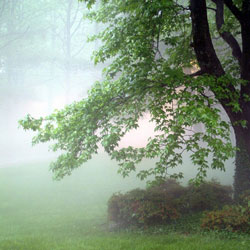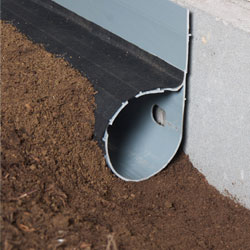Do I Have Poor Crawl Space Ventilation?
The Case Against Venting A Crawl Space -- And What To Do Instead!

Crawl space vents are based on flawed building science that assumes that most of the moisture in a crawl space comes from the dirt floor.
If the crawl space is not flooding, the majority of crawl space moisture actually enters with the humid air that enters through the vents.
More about Crawl Space Ventilation
Almost 60 years ago, contractors began to install crawl space vents in an attempt to keep a crawl space dry and protected from mold and rot damage.
The idea behind the vents was this: creating a system of cross-ventilation in a crawl space would flush out the humid, musty air in the crawl space, keeping it clean, dry, and mold-free.
Even now, general contractors will swear by this method, citing antiquated building codes that remain in place -- but are changing quickly.
Why Are The Building Codes Changing?
Because time and again (and again, and again...) contractors are finding vented crawl spaces that are moldy, rotting, and showing severe damage.
Additionally, building scientists are researching the theory behind crawl space vents, and they're finding that it's fundamentally flawed.
As building codes continue to evolve, there is continued movement in the direction of crawl space encapsulation -- a process that involves sealing the crawl space doors and vents, installing a plastic liner on the walls and floors, and installing a cool-climate dehumidifier in the space.
Sealing crawl spaces is our specialty! It's what we do every day -- and what we've done for hundreds of thousands of homeowners to date. Our warranted system is just what you need to keep your crawl space dry, healthy, and energy efficient!
It costs you nothing to meet with one of our certified experts to receive a a crawl space repair estimate! We'll customize a system that will keep your crawl space dry -- all the time!
Major Design Flaws In Ventilated Crawl Spaces
At Basement Systems, not a day goes by when the experts in our network do not see hundreds of moldy, rotting, vented crawl spaces. It's clear they're not working -- but why not, when other forms of home ventilation work so well?
What follows is three false assumptions that support crawl space venting:

Outside Air To Dries The Crawl Space
It's not often that outside air is appropriate for venting a crawl space!
For this to work, the air would have to be temperate and dry -- ruling out hot summer weather, cold winter weather, and anytime it's humid, rainy, foggy, or damp outside your home.
The Relative Humidity (RH) or air is a measurement of how much water that air can hold. For every degree you cool crawl space air, the RH of the air rises by 2.2%.
Say we have a day with 84°F air and a relative humidity of 75% RH. We vent this air into a crawl space, where the dark, underground environment, which maintains a year-round temperature of about 62°F.
As The Air Enters The Crawl Space...
So... the temperature of the air has dropped 22°F in the crawl space. If the RH rises by 2.2% for every degree drop in temperature, that's a rise in RH of (22 X 2.2) 48.4%!
But wait... if the RH of the outside air was 75%, then the new RH would be (75 + 48.4) 123.4%, and it's impossible to have more than a hundred percent! What happens now?
When the air is at 100% RH, it can't hold any more water -- it's full. Any extra water is deposited on nearby surfaces -- such as your structural wood, fiberglass insulation, iron pipes, and other surfaces in the crawl space.
That's the opposite of what we wanted the vents to do!

"Cross-Ventilation" Works
Building code specifies very exacting standards about how many vents are required for venting a crawl space. This is all done in the name of creating cross-ventilation in the space to dry it out.
However, the rules of convection and the Stack Effect show that air moves upwards in a crawl space, and indeed throughout the home.
Hot air rises upwards in the house, exiting through the attic and upper levels. As it does, a vacuum is created in the lower levels.
To fill the vacuum, air is pulled up from the crawl space, basement, and outside. As much as 40% of the air in your home's living space comes from below-grade spaces.
So What Does Venting Do For Your Home?
Open crawl space vents increase the air circulation throughout your home -- maximizing the amount of unconditioned air in your home. Meanwhile, the air in your home is exiting through the roof at an accelerated rate.
If you paid to condition that air, then you're literally throwing money out the window!

Lining The Floors & Not The Walls Is OK
Far too often, Basement Systems Dealers come across a black plastic crawl space liner installed on the floor -- with none installed on the walls.
The idea here is that most of the moisture in the crawl space will enter through the dirt floor.
While it's true that a great deal of moisture does enter through the floor, water will also pass directly through the concrete in the form of water vapor. Leave the walls bare, and you allow humidity into the space.
To properly seal your crawl space, it's important to cover all wall and floor surfaces with a durable plastic vapor barrier, as well as sealing all vents and doors.
... But What About Pest Inspector Access?
One classic argument against sealing the crawl space walls is that the surfaces need to be visible for pest inspectors. If the entire wall is covered in a plastic vapor barrier, how will inspectors be able to look for mud tubes along the sill plate at the top of the walls?
This is solved easily enough. At Basement Systems, or experts install the WallCap™ System along the top of crawl space block walls. This system seals off the open cavities of the blocks with a clear plastic piece -- keeping humidity back and your pest inspectors happy.
Four Steps To A Dry Crawl Space -- With No Venting!
Sealing and drying a crawl space can be done quickly and permanently. Basement Systems dealers send a crew of experts for each installation, who often can install a complete, warranted system in less than a day.
Our crawl space systems can be customized to accomplish many goals, including waterproofing, sealing, dehumidifying, and insulating. When installing a system in your home, our crews follow these four simple steps:

Eliminate All Sources Of Standing Water
First and foremost, it's vitally important that we eliminate any and all sources of standing water.
Our experts can install our SmartPipe™ Crawl Space Drain System, along with our sump pump system, for a long-lasting waterproofing solution. For added protection, our UltraSump® Battery Backup can be installed, which is capable of pumping more than 12,000 gallons of water on a full charge.
To keep water from being trapped underneath your crawl space, we'll install our CleanSpace® Drainage Matting underneath, which directs flooding groundwater to your sump pump system.
More about Crawl Space Waterproofing

Seal The Crawl Space Vents & Doors
Once all plumbing leaks have been repaired and groundwater flooding has been addressed, the largest source of moisture in your crawl space comes from outdoor humidity.
We strongly recommend sealing off all crawl space vents with plastic, airtight covers, as well as installing an airtight crawl space door.
If your crawl space access well is ugly, rusted, and filled with debris, this is a great time to consider installing our durable, lockable Turtl™ Crawl Space Access System(shown on the right), which is an airtight crawl space door and access well in one!
More about our Crawl Space Doors

Install A Vapor Barrier System
Next, we address water vapor and humidity that will enter your crawl space through the concrete walls and dirt or concrete floor.
To accomplish this, we will install either a crawl space liner or our crawl space insulation on the walls and floors.
Either system will create a durable crawl space vapor barrier in your crawl space to keep back moisture penetration into the space.
If you're sealing the crawl space anyways, it's not much more expensive to also insulate the surfaces. There's no better time to opt for this upgrade!
More about Crawl Space Moisture Barrier Installation

Dehumidify The Space
So now you've stopped the flooding, you've sealed away outside moisture, and you've kept humidity from entering through the walls and floors. However, wasn't the crawl space itself wet when you started? You've still got some work to do!
Installing an energy-efficient, self-draining dehumidifier will dry out the crawl space, including the air, floor joists, and other building materials.
A system with a powerful blowing motor, such as our SaniDry™™ systems, will keep dry air circulating throughout your crawl space. Perfect!
More about our SaniDry™ CX Dehumidifier
More about our SaniDry™ CSB Dehumidifier
We Create Healthy Crawl Space Environments!
At Basement Systems, our dealers are dedicated to creating dry, healthy, and energy efficient crawl space environments. We have more than 30 specialized crawl space products, that have been used in hundreds of crawl spaces worldwide!
For a free crawl space estimate from your local dealer, contact us by phone or e-mail today! Each free estimate includes an on-site professional inspection, a consultation with our experts, and a customized, written cost estimate!
We proudly serve throughout Canada and the United States. Our dealers are standing by in your neighborhood to help you!
Looking for a price? Get a no cost, no obligation free estimate.


